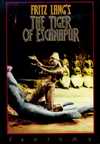The Tiger Of Eschnapur/ The Indian Tomb
Fantoma
Cast: Paul Hubschmid, Walter Reyer, Debra Paget
Extras: Still Galleries, Liner Notes
Rating:
"The Tiger of Eschnapur" and "The Indian Tomb" were two of the last films directed by the acclaimed German director Fritz Lang. Based on a story Lang originally co-authored in 1921 (and which was made into a wonderful silent film entitled "The Indian Tomb"), this pair of films has long been held in contempt by fans of the famed director. Meant to be viewed sequentially, the films were combined into one for the American market, chopped down from 201 to 90 minutes, and renamed "Journey to the Lost City." With these fully restored dual releases from Fantoma, perhaps it’s high time to give them another chance.
Harald Berger (Paul Hubschmid) is a German architect hired by Chandra, the Maharajah of Eschnapur (Walter Reyer), to help modernize the ancient Indian city. Enroute to Eschnapur, Berger rescues a beautiful temple dancer named Seetha (Debra Paget) from a man-eating tiger and the two fall madly in love. Arriving in town, Berger learns that Seetha is to become the new Maharani.
While this tale of forbidden love plays out, Chandra’s brother, Prince Ramigani (René Deltgen), plots a palace coup and schemes to use both Seetha and Harald to further his own ends. Eventually, the lovers are forced to flee for their lives at the same time that Berger’s brother-in-law partner and sister, Walter (Claus Holm) and Irene Rhode (Sabine Bethmann) arrive in Eschnapur. What ensues is a grand, old-fashioned adventure packed with intrigue, mysterious catacombs, forbidden temples, and enough visual detail to dazzle even modern audiences.
Detractors point to the predictable nature of the storyline, the awful special effects and makeup, and the fact that the high point of both films is the erotically-charged dancing of Ms. Paget as reason enough for their disdain.
Sure, neither film is a true Fritz Lang masterpiece but both are clearly the work of a talented director and storyteller. Shot on location in areas that had never before been open for foreign film crews, these two movies feature breathtaking cinematography and a wonderful sense of visual flair. The vibrant colors further enhance this atmosphere as the lush Indian landscape, the beautiful costumes and the ominous interiors are coming to life.
Both films are presented in a full-frame aspect ratio although they were likely matted to <$PS,widescreen> for theatrical presentation. The overall image quality is surprisingly good with nice vibrant colors, adequate black levels, and few physical blemishes. There is some constant faint film grain that flares up in a handful of scenes. In addition, shimmering is evident on finely-detailed surfaces and textures. But both films really do look splendid.
Audio is offered in the original German and dubbed English <$DD,Dolby Digital> mono mixes with optional English subtitles. Both tracks are of fairly good quality with very little distortion. There’s nothing spectacular here but the dialogue, score, and sound effects are all well-balanced. Frequency response is, as expected, limited and creates a presentation that is a bit on the harsh side.
Both soundtracks are essentially dubs due to the multinational makeup of the cast. The English dub is lacking many of the subtler atmospheric sound effects present on the German track so stick with the original. It’s not like these are dialogue-heavy films in the first place and the subtitles are fairly accurate and easy to read.
The only extras are short still galleries on each disc as well as very informative liner notes by Tom Gunning that must be read to fully understand the films and their proper place in Fritz Lang’s vast body of work.
"The Tiger of Eschnapur" and "The Indian Tomb" combine to form a wonderfully exciting tale that takes full advantage of its exotic Indian locations. I can’t even imagine what American audiences thought of the butchered 90-minute version they were dealt as the richness of the story requires every second of the 201-minute runtime. Fantoma is to be applauded for rescuing these films from obscurity and presenting them on DVD with such fine video and audio restorations. My only minor gripe is that it would have been more convenient if the two discs had been packaged together as no one is likely to want just one half of the story. In any case, fans of classic adventures are in for a real treat as long as they’re willing to overlook the superficial shortcomings of the two films.







